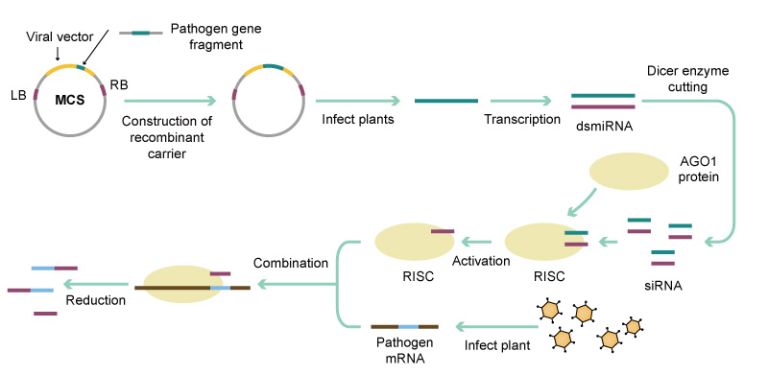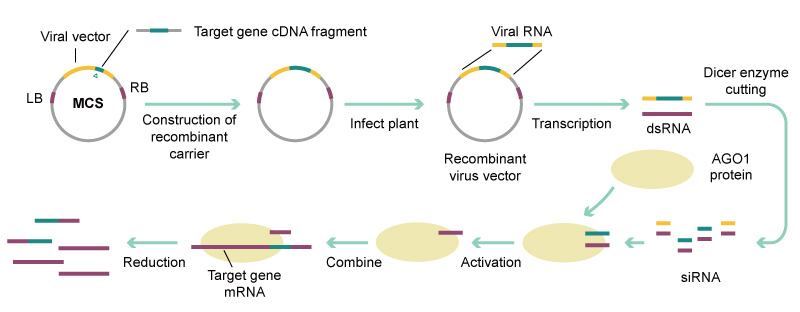RNA interference (RNAi) technology is becoming an essential tool in sustainable crop production systems. It offers numerous benefits, including crop protection, crop improvement, and resistance against economic losses caused by pests, nematodes, and viruses. RNAi technology can effectively silence defective and undesirable genes that affect the economic traits of crops, leading to improvements in crop varieties. Overall, the use of RNAi technology is vital for the development of sustainable agriculture practices that prioritize environmental conservation while ensuring food security.
RNAi technology is a highly promising form of gene regulation in functional genomics, particularly in plants. It has become a popular tool in plant genetic engineering due to its high specificity, efficiency, simplicity, transmissibility, and stability. With RNAi technology, targeted gene silencing can be achieved with remarkable precision, leading to improved crop traits and enhanced resistance to various stress factors. The stability and ease of transmission of RNAi signals in plants have further added to its appeal as a powerful tool for sustainable agriculture practices.
Advancing Plant Genetic Engineering with RNA Interference Technology
Crop Protection
RNAi technology is a powerful tool for protecting crops against pests, pathogens, and diseases. This technology has three primary applications for crop protection: host-induced gene silencing (HIGS), virus-induced gene silencing (VIGS), and spray-induced gene silencing (SIGS).
HIGS technology targets specific genes in the pathogens that infect the crop, interfering with their growth and development. This is achieved by expressing RNA molecules that complement the target pathogenic genes in host plants, which are then processed by plant cells to form siRNAs. Once the pathogen infects the host plant, the siRNAs are transferred to the pathogenic cells, where they recognize and degrade the target mRNA, ultimately affecting the pathogen’s normal growth and development and reducing disease development. Compared with VIGS, HIGS extends the silencing objects from plant endogenous genes to pathogen genes.

VIGS involves using a virus carrying a target gene fragment to infect the crop. The virus specifically induces degradation or methylation of the sequence homologous gene mRNA, resulting in changes in the crop’s phenotype or metrics.

Figure 2. VIGS Mechanism
SIGS is similar to traditional pesticide application methods but uses synthesized dsRNAs to target pathogenic factors. This technology acts through the process of pest feeding or pathogen infestation. Since dsRNA molecules are easily denatured or degraded in the environment, special formulations are required to improve the stability of the active ingredient and enhance RNAi efficiency.
Overall, RNAi technology is a powerful tool for crop protection, providing a sustainable and environmentally friendly way to enhance crop resistance to pests and pathogens, reduce the use of harmful pesticides, and promote sustainable agriculture practices.
Crop Improvement
RNAi has revolutionized plant genetic engineering, providing a powerful tool to enhance plant traits, improve crop yield and quality, and promote sustainable agriculture practices. Here are six significant applications of RNAi in plant genetic engineering:
- Alteration of Plant Architecture: RNAi has been used to alter plant architecture, resulting in improved agronomic traits such as yield, stress resistance, and flowering period. For example, RNAi interference technology has been used to produce semi-dwarf rice varieties with higher yield and lodging resistance.
- Nutrient Improvement: RNAi is safe and effective for improving the nutritional composition of crops. For instance, RNAi technology has been used to produce corn strains with high amylose content, which is healthier for people with diabetes.
- Removal of Harmful Components: RNAi technology is used to remove harmful substances in crops. For example, RNAi has been used to reduce the caffeine content in coffee plants, alleviating symptoms such as palpitations, hypertension, and insomnia.
- Abiotic Stress Tolerance: RNAi has been applied to enhance abiotic stress tolerance in plants, including drought, salinity, waterlogging, and temperature fluctuations. For instance, RNAi has been used to improve tomato plants’ drought and salinity resistance.
- Synthesis of Secondary Metabolites: RNAi is used in plant metabolic engineering to regulate the production of target substances, such as anti-cancer and anti-malaria drugs. For example, RNAi technology has been used to reduce codeine and morphine while increasing the content of (S)-reticuline in opium poppies.
- Extension of Fruit Storage Life: RNAi is used to enhance the storage life of fruits by silencing genes involved in fruit decay. For instance, RNAi technology has been used to regulate the pectate lyase gene in strawberries, resulting in longer storage time and increased fruit firmness. Inhibition of the PPO gene expression using RNAi technology has also been shown to reduce browning in potatoes and apples.
Challenges of RNAi technology
Despite its many benefits, RNAi technology faces several challenges, including:
- Insect-specific variability: RNAi technology is not equally effective against all insects, and no single approach can be applied to all species. The mechanisms of signal amplification and transmission in insect cells are still not well understood.
- Unclear uptake mechanisms: The mechanism of dsRNA uptake in host plants and invading organisms is not fully understood, hindering the development of efficient RNAi strategies.
- Accessibility issues: Some RNA target sequences may be located in highly folded regions or hidden under secondary structures, making them difficult for siRNAs to access and cleave.
- Off-target effects: Certain genes are highly homologous to target genes, resulting in incorrect silencing and unintended effects.
In conclusion, addressing these challenges is vital to realizing the full potential of RNA interference (RNAi) technology within plant genetic engineering and sustainable agriculture practices. By improving our understanding of the mechanisms underlying RNAi, such as signal amplification, dsRNA uptake, and target accessibility, we can develop more efficient and specific RNAi strategies. Addressing off-target effects and other technical challenges will require ongoing research and technological advancements. With continued progress, RNAi technology will play an increasingly essential role in promoting environmentally sustainable agriculture and ensuring global food security.
Synbio Technologies︱RNA Interference Services
As a leader in synthetic biology, Synbio Technologies is committed to supporting plant engineering efforts through our RNA interference (RNAi) services. We understand the challenges facing researchers in the field of crop sustainability and are dedicated to breaking down technical barriers to advance the use of RNAi technology in plant genetic engineering. Our tailor-made RNA synthesis services include the production of siRNA products of varying lengths, forms, modifications, and labels, as well as a range of miRNA synthesis products, inhibitors, mimics, and negative controls. With optimized production processes and strict quality checks, we provide reliable and high-quality RNA products to aid researchers in their pursuit of sustainable agriculture and food security.
References
[1] Qiao F, Zhao K J. The influence of RNAi targeting of OsGA20ox2 gene on plant height in rice[J]. Plant Molecular Biology Reporter, 2011, 29: 952-960.
de Jong, M.; Mariani, C.; Vriezen, W.H. The role of auxin and
gibberellin in tomato fruit set. J. Exp. Bot., 2009, 60, 1523-1532.
[2] Guo Q, Liu Q, A Smith N, et al. RNA silencing in plants: mechanisms, technologies and applications in horticultural crops[J]. Current genomics, 2016, 17(6): 476-489.
[3] Regina A, Berbezy P, Kosar‐Hashemi B, et al. A genetic strategy generating wheat with very high amylose content[J]. Plant Biotechnology Journal, 2015, 13(9): 1276-1286.
[4] Tilahun T, Bezie Y, Kerisew B, et al. The application of antisense technology for crop improvement: A review[J]. Cogent Food & Agriculture, 2021, 7(1): 1910157.
[5] Allen R S, Millgate A G, Chitty J A, et al. RNAi-mediated replacement of morphine with the nonnarcotic alkaloid reticuline in opium poppy[J]. Nature biotechnology, 2004, 22(12): 1559-1566.
 DNA Synthesis
DNA Synthesis Vector Selection
Vector Selection Molecular Biology
Molecular Biology Oligo Synthesis
Oligo Synthesis RNA Synthesis
RNA Synthesis Variant Libraries
Variant Libraries Genome KO Library
Genome KO Library Oligo Pools
Oligo Pools Virus Packaging
Virus Packaging Gene Editing
Gene Editing Protein Expression
Protein Expression Antibody Services
Antibody Services Peptide Services
Peptide Services DNA Data Storage
DNA Data Storage Standard Oligo
Standard Oligo Standard Genome KO Libraries
Standard Genome KO Libraries Standard Genome Editing Plasmid
Standard Genome Editing Plasmid ProXpress
ProXpress Protein Products
Protein Products
























